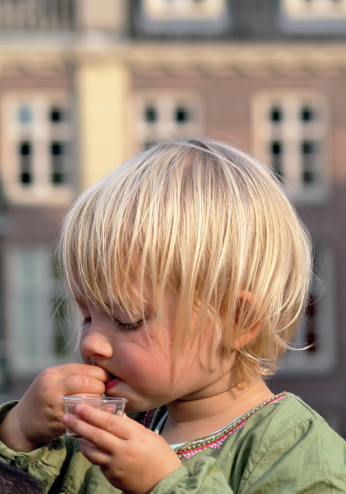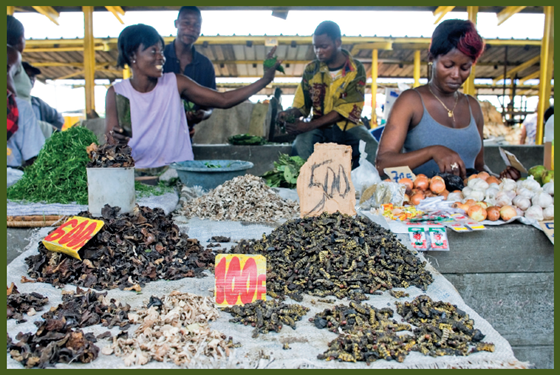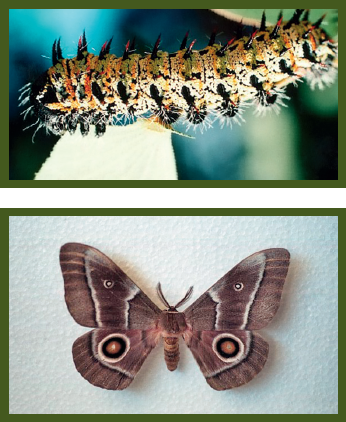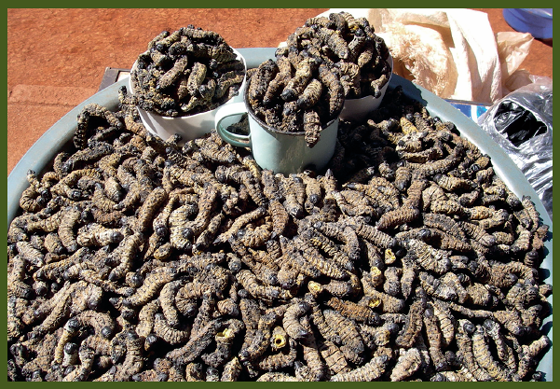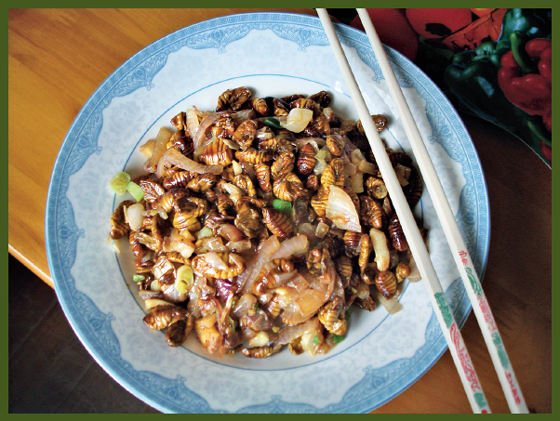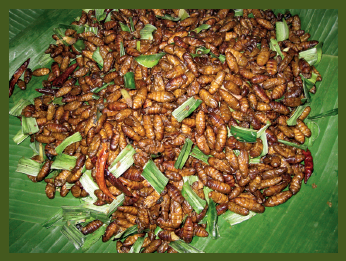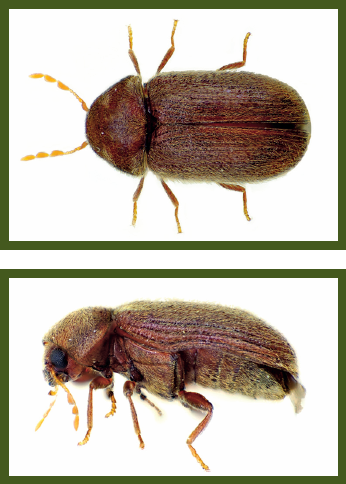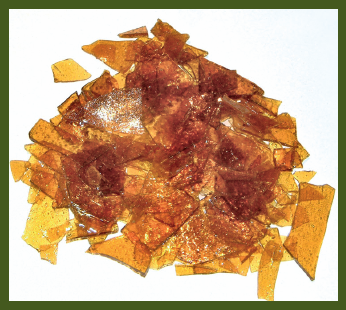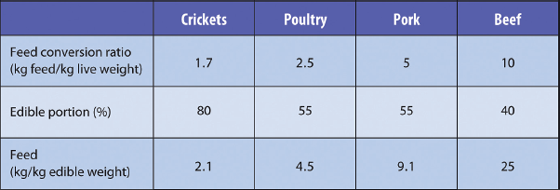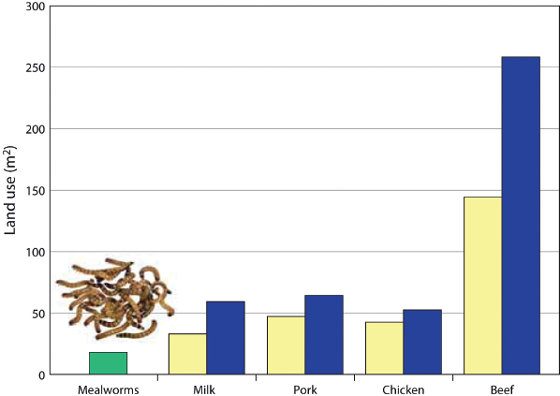Wageningen—City of Insects, 2006. (Frits Weener)
About 20 percent of all edible insects are caterpillars. Especially popular in southern and central Africa, one caterpillar species stands out among all the others. In southern Africa (Botswana, Namibia, Zimbabwe, and South Africa), in a 7,700-square-mile (20,000 sq. km) area—about the size of New Jersey or Wales—9.5 billion saturniid moth caterpillars are collected each year: more caterpillars than there are people on Earth! Their market value is approximately $8.5 million. The caterpillar feeds mainly on the mopane tree, which is why it is known as the mopane caterpillar.
The caterpillars are harvested when they are full grown and almost ready to pupate. They are hand picked from the trees, mostly by women and children who must sometimes travel hundreds of miles to areas where the caterpillars are found. After picking, the insects are pinched and squeezed to expel their gut contents, and then boiled in salted water and sun-dried. Prepared this way, the caterpillars can be stored without refrigeration for months, just like other kinds of dried fish or meat. The dried insects can be soaked in water to plump them before cooking, but local people like to eat them dried as well, as a crispy snack.
Market in the Democratic Republic of the Congo. (Giulio Napolitano FAO)
Mopane worms are an important financial resource for the rural population, representing up to a quarter of the yearly income and allowing people to buy clothes, school supplies, and household goods. The caterpillars consist of more than 60 percent protein, and contain valuable essential fatty acids as well as such minerals as calcium, zinc, and iron. Their market value often exceeds that of beef.
Mopane caterpillar and moth. (Arne Larsen)
Mopane caterpillars at a market in southern Africa. (Kenichi Nonaka)
Mopane caterpillars at a market in southern Africa. (Kenichi Nonaka)
¾ cup (100 g) dried mopane caterpillars
1 onion, finely chopped
2 green bell peppers, seeded and diced
6 medium-size tomatoes, chopped
1 to 2 teaspoons curry powder
• Rinse the caterpillars and boil them in salted water in a medium saucepan for 30 minutes.
• Drain the caterpillars and add the remaining ingredients to the pan, as well as about 2 cups (500 ml) of water.
• Simmer gently, partially covered, for about 1 hour.
• Serve with millet or maize porridge.
The story goes that silk was discovered by the Chinese empress Xi Ling-Shi (Leizu) 5,000 years ago. She found a silk moth cocoon on the mulberry tree in her garden and was able to pull a thread out of the cocoon and wind it around her finger, and then used this thread to weave cloth. For centuries, silk clothing was worn exclusively at the imperial court, and the Chinese were able to keep the exclusive secret of silk until about the year 600 C.E. Even the Roman historian Pliny the Elder got it wrong: in the year 78 C.E., he wrote in Naturalis Historia that silk grew as a downy layer on the leaves of an exotic Chinese tree, and that one could wash the silk off of the leaves with water. In China, revealing the secret of silk was punishable by death. Legend has it that monks finally smuggled some moth eggs and mulberry cuttings into Europe in a hollow stick, toward the end of the sixth century.
Dish prepared with silk moth pupae in Hangzhou, China. (Marcel Dicke)
Silk moth cocoons are about 1 inch (2 to 3 cm) long, and are made up of a single thread that can reach up to 3,000 feet (900 m) in length. Two to three thousand cocoons are needed to make about 2 pounds (1 kg) of silk. When they are ready to pupate, silk moth larvae take about three days to spin the cocoon around themselves. With the yearly worldwide silk production, you could span 180,000 silk threads from here to the moon! Silk moths have been cultivated for thousands of years. The cultivated silk moth has been bred in such a way that the adult moth is no longer able to fly. If it were to be allowed to emerge normally from its pupa, the moth would make a hole in the cocoon, so it would no longer be possible to unwind the silk thread. To prevent this, the cocoons are immersed in hot water before the moths can emerge. The silk can then be easily uncoiled.
But what to do with the leftover pupae? Eat them! Their protein content is about 60 percent, and they contain high amounts of unsaturated fatty acids, such as linoleic and linolenic acids. In China and Vietnam, people roast the cocoons on the barbecue; Koreans boil their cocoons. Boiled and canned silk moth pupae can be found at many markets in Asia, sometimes prepared in chili sauce. These canned pupae can also be barbecued or fried.
Silk moth pupae presented at an insect buffet in Thailand. (Arnold van Huis)
How do you prepare silk moth pupae? Just fry them in some hot oil. No extra salt or spices needed; they are tasty enough as is.
How can you feed yourself on another planet, where nothing grows, or while traveling through space to get there? There is limited room inside a spacecraft, especially if you also need to produce food there. Some crops can be grown in small spaces, but producing meat, fish, eggs, and dairy products is more problematic. Japanese, Chinese, and Canadian scientists suggest using edible insects. Insects can convert plant material into high-quality food. This is possible in a small space, with robots handling the rearing process. Waste products, such as insect excretions as well as dead eggs, larvae, or pupae, can serve as nutrients for the plants. In this regard, insects are completely recyclable.
Silk moth pupae. (Arnold van Huis)
This team of scientists devised a system whereby 100 people can be provided with insect protein in space, as long as there is enough food for the insects. While a large number of the insects grown could be used for human food, the rest could be used to keep the colony going. As a model insect, the scientists chose the bread beetle, or drugstore beetle (Stegobium paniceum), of which the larvae are edible. They calculated that a 13 × 15-foot (4 × 4.5 m) room that is 8 feet (2.5 m) high would be sufficient to provide 100 people with their respective daily protein requirement.
Bread (drugstore) beetle. (Siga)
Silk moth larvae appear to be another good possibility. The Chinese researcher Yang Yunan, from Beijing University’s Aerospace Department, believes that these insects will become the standard meal for Chinese astronauts because they are so rich in protein and easy to grow on leafy vegetables, using only small amounts of waste water.
Masamichi Yamashita, a Japanese scientist, agrees. At the Thirty-sixth Scientific Assembly on Space Research, held in Beijing in 2006, he presented a recipe for Savory Silkworm Cookies—not to be confused with space cakes—to be used during space travel.
Savory Silkworm Cookies
1½ teaspoon finely ground silk moths
1¼ cups (200 g) finely ground rice
1½ teaspoon finely ground soybeans
1¼ cups (300 ml) unsweetened soy milk
Soy sauce
Salt
• In a large bowl, stir the moths, rice, soybeans, and soy milk and season with soy sauce and salt to taste.
• Shape the dough into cookies on a microwave-safe baking sheet.
• Bake in a microwave oven for 15 minutes.
He calls himself a “consilience artist,” and is known as a visual artist, a dramatist, and an author. In every discipline, he has started tongues wagging—or even caused great commotion, such as the time he wrapped the pillars at the entrance to the auditorium of the Belgian University of Ghent in slices of ham. He has created various installations incorporating insects; he covered the ceiling of a room in the Royal Palace of Belgium with millions of beetle elytra (hardened forewings). Where did Jan Fabre get his fascination for insects?
Apparently, that insect fascination runs in the family. Belgian artist Jan Fabre is a distant relative of famous French entomologist Jean-Henri Fabre. Yet, whereas the scientist was interested in only absolute truths, the artist dedicates his life to beauty in the broadest sense of the word. And in that pursuit, he often makes use of insects.
FRANKENSTEIN
“As a youngster, a seven-year-old little kid, I was fascinated by things that crept around, such as spiders.” He laughs at the memory. “I studied them without a scientific method: grabbed the spider, pulled out a leg, and another leg, and another, to see what a creature like that would then do. I was a kind of Dr. Frankenstein, experimenting with little animals. I wasn’t afraid of insects. I remember that I always teased my sisters with the spiders I had caught.”
SCENT
“Later, I started a project in my parents’ garden, about scent. I built a tent in the shape of two noses, in which I sat at a table with my microscope. I was planning to create new life from odors. I started with the scent, and brought body parts together, putting the wings of a fly on a worm, for example. I had developed this idea about how things should stink.” Fabre is still doing this today. “Art is not only about form, but also about scent. Scent provides content.” In other words: “Good art should stink.”
The step from scent to taste is a small one. “Speaking of taste: I literally eat things up. I also teach my students to taste all of their materials. When people get older, they don’t do that anymore, in contrast to children. That’s a shame. I’ve always put everything in my mouth. How does copper taste? How does that color taste? And that brush? I am very physically engaged in making things. Even those spiders when I was seven. I’ve eaten everything. Even worms.” Still, the Belgian artist is not wholeheartedly enthusiastic about insects on his plate. “Naturally, I know that they eat those beautiful little bugs in many cultures. So I’ve tried that myself, and even heated them up, but I’m not a big fan. I know that they contain a lot of protein and other nutrients, but still—no. I’d rather have a steak and fries.” The innovative artist is averse to novelty when it comes to food. “There are restaurants that do—what do you call it?—molecular cooking. It’s really expensive, but I don’t think much of it.”
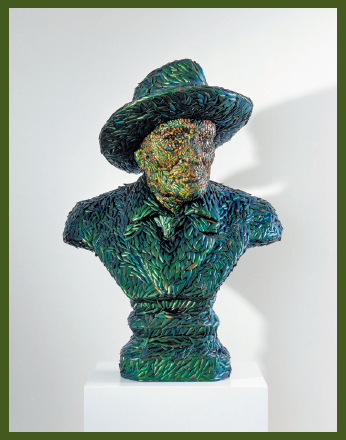
Jan Fabre, homage to the famous entomologist Jean-Henri Fabre. Jewel beetle forewings on plaster, 2004, 68 × 47 × 33 cm. Installation view, Messengers of the Death, Salzburg (MAM Collection, Salzburg). (Studio Ghezzi © Angelos)
JEWEL BEETLES
“In 1992 or 1993, I made my first sculptures with real jewel beetles or jewel scarab beetles.” Later, the artist switched to using only the insects’ elytra. “There have been a few incidents. In the second half of the nineties, at the Venice Biennale—the queens of both the Netherlands and Belgium were present—larvae were dropping out of my sculpture. It turned out that a fly had laid eggs in it. The queen said, ‘Something’s alive. Is that normal?’ Yes, because good art should die before the eyes of the viewers. All great art is preparation for death. Still, since then I did make the move from whole insects to only the forewings, for practical and hygienic reasons.” For the world-famous ceiling art in the Mirror Room of the Royal Palace of Belgium in Brussels, for example. “If I had chosen to use whole beetles for that, surely a moment would have come when the queen or another distinguished person would find a larva in her champagne glass.”
A MILLION AND A HALF
Whether you like it or not, that ceiling is an impressive work. “I used a million and a half jewel beetle forewings. I had arranged for them to be collected for two whole years at restaurants in Indonesia, Malaysia, and the Congo, where they are actually barbecued on skewers. The beetles resulted in a mosaic of light on the ceiling. In the drawings of that mosaic, I put in all kinds of references to our colonial history. I expressed criticism of that history, by using skulls, severed giraffe legs, disfigured animal species, and elephant tusks. As colonists, we actually plundered half of the Congo; we tortured people for diamonds and ivory. But internationally, the criticism was overlooked. It was only about how sublime that artwork was. How beautiful, how the colors changed. And of course it is breathtaking and overpowering when you see it in the light, especially in a palace room like that.” It led Fabre to use jewel beetle forewings to make another work and again express his criticism of Belgium’s colonial past.
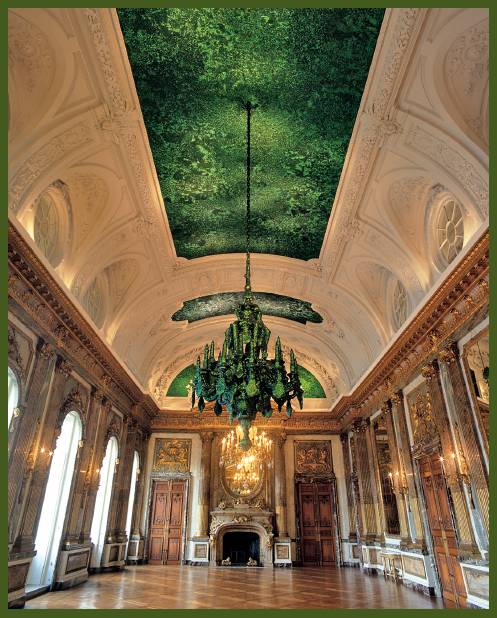
Jan Fabre, jewel beetle forewings on the ceiling of the Mirror Room, Royal Palace, Brussels, 2002. (Dirk Pauwels © Angelos)
SYMBOL
As severely as he speaks of that subject, he talks lovingly of insects. “I notice that the better collectors, museum directors, and curators see the beauty of it. They can place it in the context of Flemish and Italian art history. Yet the same eminent international art collectors say, ‘My wife could not live with those insects; she thought it was disgusting.’ That’s why my work isn’t hanging in their living room. We live in a society in which people take everything they don’t know, and everything that doesn’t make quick money, and sweep it under the carpet. I see the beetles as a bridge between life and death. And death, then, is something positive, an energy field.”
It says something about our society that we are afraid of these fantastically beautiful little beings. And that we think we can do without them, which of course is not true. I always tell people that insects live in every healthy house. A house is not healthy without insects.”
First, we eat with our eyes. When shopping, we select fruits and other foods that look unblemished and glossy. Just take a look in a store at how many foods sparkle at us. Shiny things are attractive; the implication is that they are pure and wholesome. The food and candy industry makes clever use of this. Fruits are usually treated to make them shine, and candies and chocolates are often coated with a special finish as well.
Shellac (food additive number E904) is an important glazing agent used in the food industry. It is a natural product that comes from the lac scale insect (Laccifer lacca) from India. This insect feeds on tree sap and is related to aphids and the cochineal scale insect. Shellac is a substance secreted by the lac scales, and these insects use it to make a protective shell. Branches are often completely covered with shellac. It can be scraped off, then dried and purified.
Shellac is used not only as a glazing agent on fruits and candy, but also as a coating on timed-release medications because it is resistant to gastric acids. In the past, shellac was also one of the components of 78-rpm phonograph records, before the advent of vinyl.
Shellac. (Ivory)
Both the Bible and the Qur’an refer to manna: the heavenly bread that would rain down from the sky, and that could be gathered up from the ground but not kept for very long. Manna was perceived as a gift from God. Biologically speaking, manna is the sweet substance also known as honeydew, which comes from plants and is exuded as a sticky residue by aphids, and also by jumping plant lice.
There are examples of this honeydew manna in South Africa and in Australia. It is called mopane bread in South Africa, because the honeydew is produced by jumping plant lice, also called psyllids, living on mopane trees. The sweet secretion dries up into small, hard, conical, and transparent structures also known as lerp. This term actually describes not only the manna, but the entire combination of the insect, the scales it sheds, and its secretions. Locals gather up the lerp, grind it into flour, and store it for when other food is scarce. Lerp can be collected only in the dry season, because rain washes it off the leaves. It can make a good meal when mixed with milk into a kind of porridge. Mopane bread has 250 calories per 3.5 ounces (100 g) and is high in carbohydrates, potassium, and phosphorus, but has little protein. Two other lerp consumers—the mopane caterpillar and the elephant—compete with humans. Both of these animal species are very fond of mopane leaves.
The Australian Aboriginal people use lerp from an Australian species of jumping plant lice, as a sugar source. This insect lives in eucalyptus trees. The Aboriginals gather the conical lerp structures, which are 2 millimeters high and 4 millimeters in diameter, from the affected leaves. Sometimes they even chop down an entire tree so as to facilitate the lerp harvest.
Dirck Metius (seventeenth century, Alkmaar), Willem van Loon and His Family as Israelites Gathering Manna (Exodus 16:17–31). Royal Netherlands Academy of Arts and Sciences (Koninklijke Nederlandse Akademie van Wetenschappen), Amsterdam.
The Food and Agriculture Organization of the United Nations (FAO) estimates that livestock is responsible for 18 percent of all greenhouse gas emissions, and is, as such, an important contributor to global warming. Greenhouse gas emissions include methane (CH4) and nitrous oxide (N2O). Simply by burping and passing gas, cattle release more than one-third of all methane emissions worldwide. Methane contributes twenty-three times more to global warming than does carbon dioxide (CO2), the most important greenhouse gas emitted by cars. Livestock generates close to two-thirds of all nitrous oxide released; this gas is 289 times more damaging than CO2. Some insects, such as termites, also produce methane, releasing 4 percent of all emissions of this gas worldwide. By contrast, the edible insects mentioned in this cookbook, such as mealworms and migratory locusts, produce far less greenhouse gas per kilogram of product than do cows or pigs.
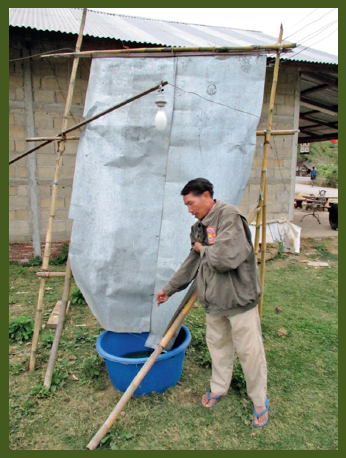
Insect trap near Luang Prabang, Laos. Insects, attracted by the lamp at night, fly into a sheet of aluminum and fall into a tub of water. This is how the edible insects are gathered. (Arnold van Huis)
Marieke Calis in the mealworm-rearing room. (Lotte Stekelenburg)
Livestock also produces more than two-thirds of the world’s ammonia emissions, which are one of the main causes of acid rain. Per kilogram of body weight produced, pigs produce fifty times more ammonia than do locusts.
Insects are cold-blooded; they do not need to metabolize food to maintain a constant body temperature. That is why insects are so efficient at converting feed to an edible product. A mere 4.6 pounds (2.1 kg) of feed is sufficient to produce 2.2 pounds (1 kg) of edible crickets, whereas 55 pounds (25 kg) of feed is needed to produce 2.2 pounds of beef.
Production of greenhouse gases (gram CO2 equivalents per kilogram of growth) by edible insects, compared with pigs and cattle.
Production efficiency of edible crickets, compared with poultry, pork, and beef. (Adapted from Arnold van Huis, “Potential of Insects and Food and Feed in Assuring Food Security,” Annual Review of Entomology 58 [2013]: 563–83)
As well as looking at what an animal itself produces in terms of greenhouse gases, it is also interesting to consider all environmental impacts associated with producing conventional meat or insects. For example, we can take into account the environmental impact of producing the fodder for the animal (sowing, irrigation, fertilizing, transporting the feed to the animal, the energy used at the farm, and the like). This has recently been analyzed for mealworms and compared with milk, pork, chicken, and beef production with respect to three parameters: energy use, greenhouse gas production (global warming potential), and land use.
Land required for the production of 1 kilogram (2.2 pounds) of edible protein. ([green bar] Data from Dennis G. A. B. Oonincx and Imke J. M. de Boer, “Environmental Impact of the Production of Mealworms as a Protein Source for Humans: A Life Cycle Assessment,” PLoS One 7, no. 12 [2012]: e51145; [yellow and blue bars] minimum literature data)
The energy used to produce 2.2 pounds (1 kg) of protein from mealworms is lower than that for beef, comparable to pork, and slightly higher than for chicken and for milk. The greenhouse gas emissions resulting from mealworm production are much lower than for the more commonly farmed animals. For the production of milk, pork, and chicken, more land is required than for the production of mealworms, but to produce beef, ten times as much land is needed. The amount of land needed for production is an important factor to consider, as two-thirds of the agricultural land on our planet is already being used for livestock.
Although he and his wife very occasionally allow themselves a piece of meat, Dutch economist Herman Wijffels has been a confirmed vegetarian for twenty years. “I feel good about that.” In his view, insects fall into a category between conventional animal proteins and pure vegetarian ones. Yes, he is open to eating them. “Most likely, it can even increase the diversity in our diet.” But it turns out there are more reasons for having insects on the dining table.
Eating insects is not only exciting or delicious—it’s also necessary. Maybe even inevitable. To understand why, Herman Wijffels goes back to the basis of our economic system. In any case, the way we produce food right now can’t go on for long. “We are running up against physical limitations. It hasn’t quite gotten through to us yet, but for the first time in the history of humanity, we are in the predicament of exhausting our natural resources. We call it overshoot: we are overtaxing our fresh water sources, our agricultural land, and the ocean’s fish supplies.” As a former banker, he compares the food industry to the financial market. “For part of the year, we’re living on the principal of our natural capital, instead of on the interest. If you want to live sustainably, you can’t take more out of the natural resources than what is being added to them. But that is happening, and on a large scale.”
CYCLE
“That’s why we are now working on the development of new economic processes. From the old linearly organized economic processes toward circularly organized processes. The most prominent characteristic of circular is much more efficient management of such natural resources as fossil fuels and minerals.” In practice, for example, you strive to reuse instead of to destroy. “At the end of a product’s life span, you don’t throw it away; you use the raw materials again for subsequent production. Cycle upon cycle upon cycle.”
“My whole way of thinking at this point is infused with the idea that every investment we make should reduce our environmental footprint. At the global level, our footprint is one and a half times the structural carrying capacity of our planet. The vision we work with is to replace processes that create a bigger footprint with processes that reduce it. That’s how we evaluate every innovation.”
CONVERSION FACTOR
What does that have to do with insects? A great deal. Because they can be reared incredibly efficiently, whether abroad or just around the corner.
Wijffels: “I read in the newspaper that a third of the farmland in the world is showing signs of a serious degree of exhaustion. Our methods of working the land are systematically harming the soil. We should be harvesting responsibly, and making use of the possibilities that biological circumstances offer. Insects require little space. Furthermore, they have a high conversion factor. That is, you don’t have to give them much to eat in order to yield a high nutritional value. For just 2 pounds [1 kg] of beef, you also need about 10,600 gallons [40,000 L] of water. I don’t think we can keep this up. The capacity for that just doesn’t exist.”
COLD BLOODED
For insect production, though, there does appear to be sufficient capacity at the global level. The conditions for insects to grow are most favorable in the tropics. Insects are cold-blooded: they take on the temperature of their environment. And they develop better at the high temperatures of the tropics than in temperate zones, especially during our cold winter. “Farming insects in the tropics and transporting them to Europe fits into the circular way of thinking.”
Then again, Wijffels also sees possibilities for farmers in the Netherlands to rear insects, just as there are now farmers who have begun producing algae. “As long as it is economically feasible for them. A big advantage to insect production is that you break the cycle of importing nutrients from overseas that creates a surplus here and a shortage there. You can make use of local organic waste materials for the production of insects: you close the loop. It fits perfectly into a circular economy.” Because, by using residual streams as food, you create a closed circuit.
DETOUR
“Using vegetable materials to produce animal proteins is a detour. Strictly speaking, everything we need in order to live is found in plants. I expect that we will be avoiding that detour more and more. According to the WHO [World Health Organization], the effects of overconsumption of animal proteins on health are not very good. In a balanced diet, there is less room for animal protein. So the market for animal proteins will be shrinking. You have to take that into account when calculating the feasibility of insect production.”
But will animal protein consumption increase in such countries as China and India? Does the growing Chinese population mean, by definition, that we should be seeing a shortage of animal proteins? Not necessarily. “For the sake of convenience, people assume that the same developments will occur there as here. That may be a possibility in China, but not in India. The Indian diet is much more vegetarian. If you go to an Indian restaurant, the emphasis is often on vegetables. Meat plays a much less dominant role than in Western cuisine. So I hesitate to directly translate the development to ‘what has happened here will also happen there.’ But that the growing prosperity in China and India will mean an increased demand for animal proteins in the coming decades seems quite obvious. The question is how that will play out in terms of prices. If the Chinese triple their consumption of sweet-and-sour pork, they certainly won’t make it.” There’s too little livestock, as well as a shortage of livestock feed. “The way the future looks now, the total world trade volume of grain and soy would go to China. Naturally, that can’t happen.”
INFANCY
“I don’t exclude the possibility that new market niches can be developed in which animal protein based on insects—with their favorable conversion factor—is a better option than protein with an unfavorable conversion factor. More research on that is needed. Actually, it’s crazy that so much research is done in the food industry, yet exploiting insects as an animal protein source is still in its infancy.”
The crude insect product can be processed. But before the food industry truly sees the point of these “new” products, Wijffels suspects, enormous volumes of insects will have to be available. But then again, if the conversion factor is only 4.6 pounds (2.1 kg) of feed to 2.2 pounds (1 kg) of edible body weight gain, and insects can be grown on organic residual streams, “then it could be done,” the economist declares.
FUTURE
Does he really think it will happen? “Why not? I think that the average Dutchman would rather have a pork chop on his plate than an insect. But in other parts of the world, people enjoy eating insects.” And fortunately, the Dutch sometimes allow themselves to be seduced into a little culinary development. “Just look at how international food culture—and certainly not just Chinese food—has found its way into Dutch culture. We stopped eating only meat and mashed potatoes a long time ago.”
Attendees tasting tidbits at an insect-cooking competition in Laos. (Thomas Calame)
The FAO predicts that by the year 2050, 70 percent more food will need to be produced, to feed the world’s growing population. Paul Vantomme, senior forestry officer of the FAO, explains why insects are of global importance as a source of protein.
Our current food production methods will have to become more efficient. Furthermore, “new” foods, such as algae, seaweeds, or insects, will need to be developed. Our production, processing, and distribution systems will also have to become more sustainable. We will have to take into account the changing growing conditions related to climate change and water scarcity. These are reasons why the FAO is studying how insects can play a part in food security.
Insects are already a delicacy for some 2 billion people. The majority of insects that are now eaten worldwide are harvested in the wild. For the most part, this harvesting takes place in the tropics—especially in forests, to reduce the risk of exposure to pesticide residues. “Farming” insects occurs on a small scale, predominantly in developed countries, and is usually for the purpose of feeding pets or fish. In such countries as Thailand, Laos, and China, insects are also grown for human consumption. In terms of technique, catching or farming insects is relatively simple. In developing countries, women and children are usually the ones to gather insects, as a supplement to their own meals. Women, as well, are primarily the ones who sell dried or prepared insects at the local market. For many families, then, growing and selling insects is an essential source of income. Insect farming has the added advantage that it is not dependent on owning land and does not require expensive equipment. Grasshoppers, for example, can be grown in an old oil drum, even on the balcony of an apartment in the city, or under a bridge. What’s more, insects can be fed with leaves or other organic material that can usually be collected for free, even in the cities. In Thailand, for example, about 20,000 families are farming crickets this way, and then drying and selling them as feed for chickens and fish, and also for human consumption.1 Thanks to these activities, the monthly income can reach as much as $120, which is a lot of money in a country where the average monthly income is $80 per person. Insect farming can thus help combat poverty, in cities as well as in the countryside.
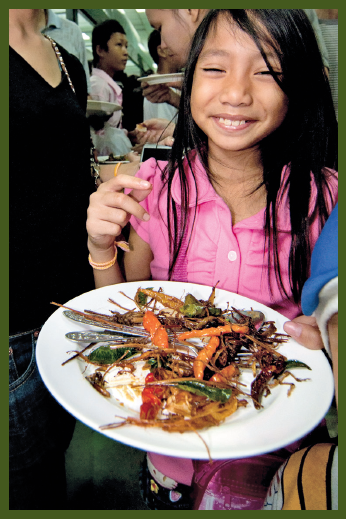
Girl tasting tidbits at an insect-cooking competition in Laos. (Thomas Calame)
Before insects become a large-scale, nourishing food product for humans and animals worldwide, much is yet to be done. In the Western world, we need to overcome culturally determined aversion. Additional research is also needed to make insect farming more cost-effective. Most important, insects must be turned into an appealing product. Food based on insects will, after all, have to compete with traditional and inexpensive meat products. And last but not least, insect-based dishes have to taste delicious; hence this cookbook as a source of inspiration for adventurous and innovative cooks.2
Since 1997, we at Wageningen University have been drawing attention to the fantastic new possibilities that eating insects can bring. At first, the reactions were characterized—understandably—by disbelief. As the years have gone by, however, it has become clear that the future looks bright for insect consumption; people have been increasingly positive and interested. One example is an article that appeared in the Dutch Railways magazine Tussen de rails (Between the Rails) around the turn of this century, about trends we would be seeing in the new century—one new phenomenon was described per year. For 2016, the prediction was the opening of the first insect fast-food restaurant, MacCricket.
Interest in eating insects has skyrocketed since 2000. In 2005, former Dutch minister of agriculture Cees Veerman spoke of the need to find alternative animal protein sources for the incessantly growing world population. In 2006, the entomologists at Wageningen University transformed the town of Wageningen into the “City of Insects,” an event including an attempt to set a world record for insect consumption. Simultaneously, a total of 1,747 people crowding the city’s main square ate mealworms prepared and distributed by professional cooks. Several Dutch companies have started growing insects for human consumption, and these companies also founded the trade organization Venik (Verenigde Nederlandse Insectenkwekers [Dutch Insect Farmers Association]). As a result, insects are now commercially available in the Netherlands through the wholesaler Sligro, and can also be bought from online retailers (see page 180). In 2008, the Horecava (annual food exhibition) presented insects as the food of the future—9,500 visitors tasted them. Former Dutch minister of agriculture Gerda Verburg served up an insect meal to her European Union colleagues in 2010. The consumer program Radar questioned visitors to its Web site in May 2010, regarding their views on eating insects; a surprising 30 percent said they would be willing to try. A 2011 contest voted in the favorite new word in the Frisian language: hipperhapke, a translation of the Dutch term for “insect snack.” The same year, Marcel Dicke and Arnold van Huis, two of the authors of this book, were invited to write an article for the Wall Street Journal about insect consumption in the Western world.3 In 2013, the book Edible Insects: Future Prospects for Food and Feed Security, coauthored by Arnold van Huis, was downloaded 2.3 million times in the first twenty-four hours after its launching—a demonstration of worldwide interest in this topic.
An article in the December 24, 2010, issue of New Scientist presented a “retrospective” as told from the year 2050.4 This article recounted that, in 2030, insects had become a breakthrough solution to the meat crises that had afflicted the world for years. The author of the article pointed to the many advantages of insect meat compared with regular meat, and wondered why these advantages had remained misunderstood for so long. Indeed, we now know that producing insects is economically advantageous, leads to less environmental damage (in terms of greenhouse gas and ammonia emissions), holds fewer health risks for humans, and yields a product that is comparable in quality to chicken, pork, or beef. It therefore seems logical to eat insects, but our impression of insects as dirty, creepy, and “to be avoided” has sustained a barrier to innovation for a long time. Therein lies our challenge for the coming years: to discover the many advantages of insects and to overcome prejudices. The best way to do that is to put the spotlight on the importance of insects for life on Earth, and to let people taste how delicious they are. During the Insect Experience Festival in Wageningen in 2011, we could barely keep up with the demand for pancakes and Popsicles containing visible mealworms. Visitors were eager to taste them, and combining the insects with well-known foods worked well.
In the past few years, people have been asking us regularly where you can buy insects, and how to cook them. Now that the first suppliers are established, we thought it was high time for an insect cookbook. With this book in your hands, you can experiment to your heart’s content. Without a doubt, many more new, delicious recipes will follow.
